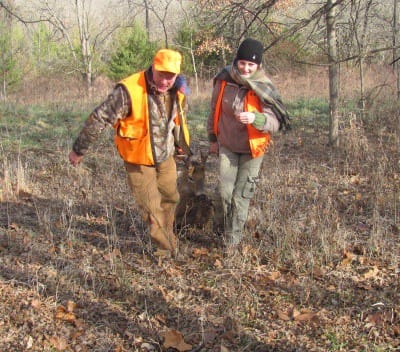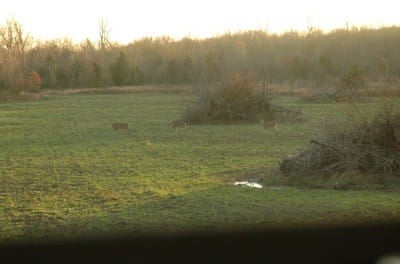
For some of us, there’s still a wait until whitetail season begins. At my place in Kansas, though I’m still waiting, I’ve spent the last couple of weeks “hunting” really hard: scouting, siting stands, preparing food plots.
While the actual shooting is restricted to a finite and well-defined period, there’s considerable value in “hunting” throughout the year, but you have to keep it in perspective. For most of the year whitetail movement is about cover for security and bedding, and food sources and movement in between. Bedding grounds may stay more or less constant, but food sources change, not only with the season but with the year. So the stands I’ve been siting shouldn’t be based on August movement, but on what I expect the deer to be doing in the late fall.
Obviously, the deer are going to do what they’re going to do, and the weather will be what it is. So suppositions made in summer could be completely wrong. Last year I made a classic blunder. I have a large food plot that was planted in winter wheat. Thanks to good late rain the wheat was gorgeous when rifle season rolled around. We’re allowed to use feeders in Kansas, so for dessert the deer had some nice, crunchy corn. Having set such a lovely table for my customers, of course that’s where I expected them to be, and there was enough sign in the field and around the feeder to support this. Good grief, I threw away a third of our rifle season without seeing an antler!
It finally occurred to me that we had a record acorn crop, and whatever daylight movement there was probably took place in the woods. I moved to ladder stands on oak ridges, and immediately started seeing bucks. This year things will probably be different. While scouting for perfect trees for stands, I looked at a lot of oaks, and there are almost no acorns this year. The effect is already visible in deer movement. All summer we’ve been seeing deer out in the open at all hours of the day, clearly reflecting a difference in food sources.
So, other than as movement corridors, the oak ridges probably won’t be as popular this year as they have been the last couple of seasons. Those movement corridors are important, but this year ideal stand locations need to take into account nearby agriculture, which will be more important… and food plots, which (I hope) will also be more important.

Movement, especially buck movement, changes considerably during the rut, and becomes much more random. Bucks will wander far from their home territories in search of receptive does, and activity can be pretty much around the clock. On one level, this is the ideal time to hunt whitetails: The elusive “peak of the rut” is the time when mature bucks are most likely to make mistakes, and the time when, despite serious scouting and even trail cameras, bucks that have never been seen before turn up. On another level, I tend to think the rut is somewhat over-rated. The problem with it is movement becomes extremely random. While you may see a monster whose very existence was unknown, you can’t pattern a whitetail during the rut. He may go walkabout in search of does, or he may take a doe into a secret boudoir and stay hidden with her for a couple of days.
Ideally, I actually prefer the pre-rut phase. At this time of year bucks are rubbing and scraping, marking their territories – and pretty much sticking to them. During this period you can identify bucks and specifically hunt them.
In Kansas, bowhunters have the luxury of hunting both the pre-rut and the actual rut. Rifle season traditionally opens the Wednesday after Thanksgiving, so gun hunters are pretty much relegated to the post-rut period. With luck there may be a bit of residual or secondary rut activity, but the peak of the rut is long past, and this is mostly the post-rut period. This is probably the most difficult time to hunt mature bucks. They are exhausted and are generally solitary, licking their antler wounds. They are hungry, but their primary movement will be nocturnal. Cold weather, which may or may not happen, helps a lot, but there isn’t much to be done about this other than to understand the situation and hunt food sources and, perhaps more importantly, movement corridors between bedding grounds and food.
One very small advantage to a post-rut season is that movement shouldn’t change much between the end of the rut and spring. With cold weather and snow, deer may become more active and more visible, but favored bedding grounds should remain constant, and unless food sources change movement routes will also remain fairly constant. So late winter is a great time for scouting, when trails have been well-used and are most visible. Movement will change when things green up in the spring, may change again in the summer when crops ripen, and will probably change again as the rut nears. But major late-winter trails will probably see at least some use throughout the year, and will almost certainly be traveled during the post-rut phase.
Early in the spring is the time to hunt for shed antlers, before the rodents gnaw them away. The location of sheds may not be of great utility for a hunting season six or eight months in the futu, but sheds are proof positive of a buck that got away and survived the winter. The trick lies in figuring out where he might be the next fall!



